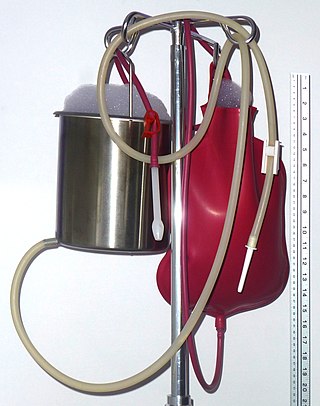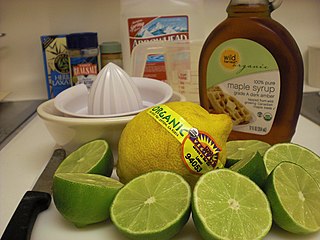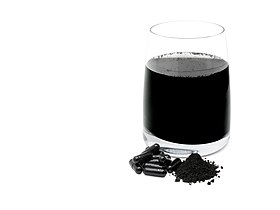
A poison is any chemical substance that is harmful or lethal to living organisms. The term is used in a wide range of scientific fields and industries, where it is often specifically defined. It may also be applied colloquially or figuratively, with a broad sense.
An antidote is a substance that can counteract a form of poisoning. The term ultimately derives from the Greek term φάρμακον ἀντίδοτον (pharmakon antidoton), "(medicine) given as a remedy". Antidotes for anticoagulants are sometimes referred to as reversal agents.

Strychnine is a highly toxic, colorless, bitter, crystalline alkaloid used as a pesticide, particularly for killing small vertebrates such as birds and rodents. Strychnine, when inhaled, swallowed, or absorbed through the eyes or mouth, causes poisoning which results in muscular convulsions and eventually death through asphyxia. While it is no longer used medicinally, it was used historically in small doses to strengthen muscle contractions, such as a heart and bowel stimulant and performance-enhancing drug. The most common source is from the seeds of the Strychnos nux-vomica tree.
Detoxification or detoxication is the physiological or medicinal removal of toxic substances from a living organism, including the human body, which is mainly carried out by the liver. Additionally, it can refer to the period of drug withdrawal during which an organism returns to homeostasis after long-term use of an addictive substance. In medicine, detoxification can be achieved by decontamination of poison ingestion and the use of antidotes as well as techniques such as dialysis and chelation therapy.

Activated carbon, also called activated charcoal, is a form of carbon commonly used to filter contaminants from water and air, among many other uses. It is processed (activated) to have small, low-volume pores that greatly increase the surface area available for adsorption or chemical reactions that can be thought of as a microscopic "sponge" structure.. Activation is analogous to making popcorn from dried corn kernels: popcorn is light, fluffy, and its kernels have a high surface-area-to-volume ratio. Activated is sometimes replaced by active.
Detoxification is a type of alternative-medicine treatment which aims to rid the body of unspecified "toxins" – substances that proponents claim accumulate in the body over time and have undesirable short-term or long-term effects on individual health. It is not to be confused with detoxification carried out by the liver and kidneys, which filter the blood and remove harmful substances to be processed and eliminated from the body. Activities commonly associated with detoxification include dieting, fasting, consuming exclusively or avoiding specific foods, colon cleansing, chelation therapy, certain kinds of IV therapy and the removal of dental fillings containing amalgam.

Juice fasting, also known as juice cleansing, is a fad diet in which a person consumes only fruit and vegetable juices while abstaining from solid food consumption. It is used for detoxification, an alternative medicine treatment, and is often part of detox diets. The diet can typically last from one to seven days and involve a number of fruits and vegetables and even spices that are not among the juices typically sold or consumed in the average Western diet. The diet is sometimes promoted with implausible and unsubstantiated claims about its health benefits.

Whole bowel irrigation (WBI) is a medical process involving the rapid administration of large volumes of an osmotically balanced macrogol solution, either orally or via a nasogastric tube, to flush out the entire gastrointestinal tract.

Bamboo charcoal is charcoal made from species of bamboo. Bamboo charcoal is typically made from the culms or refuse of mature bamboo plants and burned in ovens at temperatures ranging from 600 to 1200 °C. It is an especially porous charcoal, making it useful in the manufacture of activated carbon.
Hemoperfusion or hæmoperfusion is a method of filtering the blood extracorporeally to remove a toxin. As with other extracorporeal methods, such as hemodialysis (HD), hemofiltration (HF), and hemodiafiltration (HDF), the blood travels from the patient into a machine, gets filtered, and then travels back into the patient, typically by venovenous access.
A coffee enema is the injection of coffee into the rectum and colon via the anus, i.e., as an enema. There is no scientific evidence to support any positive health claim for this practice, and medical authorities advise that the procedure may be dangerous.

Colon cleansing, also known as colon therapy, colon hydrotherapy, a colonic, or colonic irrigation, encompasses a number of alternative medical therapies claimed to remove unspecified toxins from the colon and intestinal tract by removing supposed accumulations of feces. Colon cleansing in this context should not be confused with an enema which introduces fluid into the colon, often under mainstream medical supervision, for a limited number of purposes including severe constipation and medical imaging.

Charcoal is a lightweight black carbon residue produced by strongly heating wood in minimal oxygen to remove all water and volatile constituents. In the traditional version of this pyrolysis process, called charcoal burning, often by forming a charcoal kiln, the heat is supplied by burning part of the starting material itself, with a limited supply of oxygen. The material can also be heated in a closed retort. Modern charcoal briquettes used for outdoor cooking may contain many other additives, e.g. coal.

Master Cleanse is a modified juice fast that permits no food, substituting tea and lemonade made with maple syrup and cayenne pepper. The diet was developed by Stanley Burroughs, who initially marketed it in the 1940s, and revived it in his 1976 book The Master Cleanser. Proponents claim that the diet tones, reduces and cleanses the body, allowing the body to heal itself. There is no evidence that the diet removes any toxins or that it achieves anything beyond temporary weight loss, followed by rapidly regaining the lost weight.

The New York Rescue Workers Detoxification Project was founded in New York City in 2003 with the stated purpose of treating rescue workers for toxins inhaled from the smoke of the September 11 attacks. It has two clinics: Downtown Medical on Fulton Street, two blocks from the site of the World Trade Center, and another at Williston Park, Long Island. The project's co-founder and top fundraiser is actor Tom Cruise. It uses the Purification Rundown, a detoxification program invented by L. Ron Hubbard as part of Scientology's Bridge to Total Freedom. This rundown has been criticized by many doctors as pseudoscientific and medically dangerous. It was reported in October 2007 that 838 people had completed the New York program.

Activated charcoal, also known as activated carbon, is a medication used to treat poisonings that occurred by mouth. To be effective it must be used within a short time of the poisoning occurring, typically an hour. It does not work for poisonings by cyanide, corrosive agents, iron, lithium, alcohols, or malathion. It may be taken by mouth or given by a nasogastric tube. Other uses include inside hemoperfusion machines.

Charcoal is used in food to colour it black and for its supposed health benefits.
Anthony William Coviello, known professionally as Anthony William or the Medical Medium, is a self-proclaimed medium who offers pseudoscientific health advice based on alleged communication with a spirit. He authors books and offers advice online on forums such as Gwyneth Paltrow's Goop column and his own website. William believes that the Epstein-Barr virus is responsible for multiple ailments, including cancer. He claims to be the originator of the lemon juice in water morning detox as well as celery juicing, which he claims can offer many health benefits. Critics allege that he is practicing medicine without a license and that he has, at times, improperly solicited positive Amazon reviews for his books.

Detoxification foot baths, also known as foot detox, ionic cleansing, ionic foot bath and aqua/water detox are pseudoscientific alternative medical devices marketed as being able to remove toxins from the human body. They work by providing an electric current to an electrode array immersed in a salt water solution. When switched on, the electrodes rapidly rust in a chemical process called electrolysis which quickly turns the water brown. This reaction happens regardless of whether or not a person's feet are immersed in the water and no toxins from the human body have ever been detected in the water after use.

Kambo, also known as vacina-do-sapo, or sapo, is the dried skin secretions of the giant leaf frog, a species of frog, used as a transdermal medicine; however, evidence for its effectiveness is limited.




















